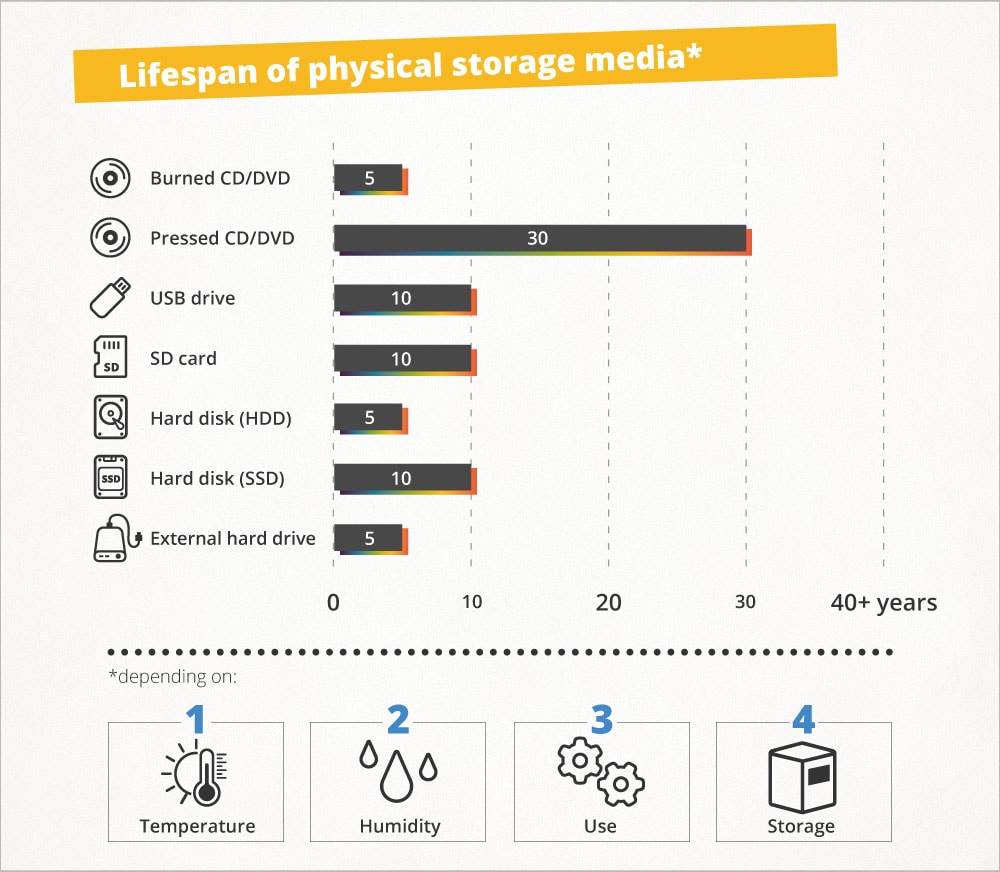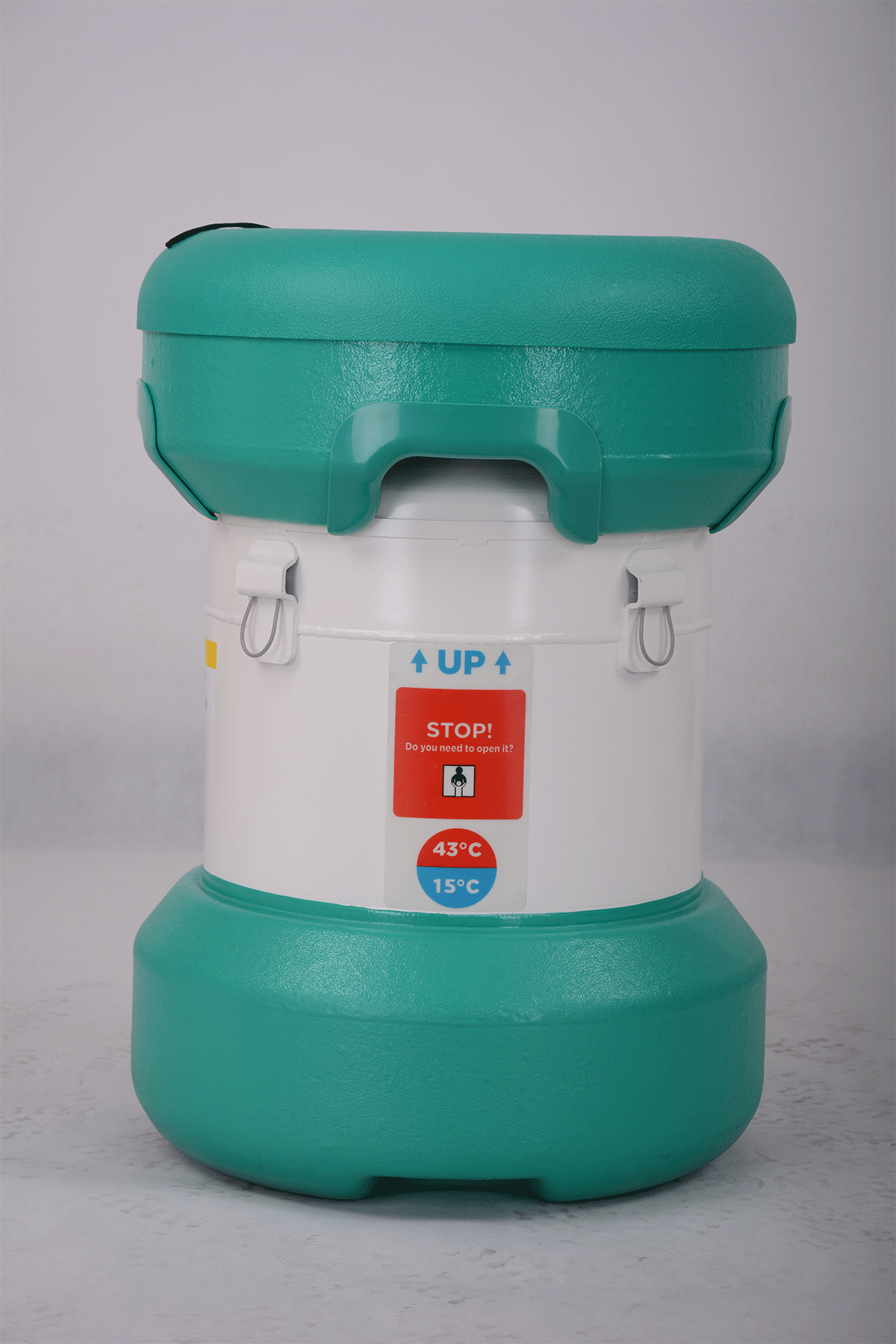Imagine finding a dusty box in your attic filled with old photographs and letters, each holding a memory you thought was lost. Now, think of your digital life.
What happens to your cherished memories, crucial documents, and favorite music playlists over time? This is where long-term storage devices come into play. These devices are like trusted guardians for your digital treasures, ensuring they remain safe and accessible for years to come.
Whether you’re a photography enthusiast with a collection that keeps growing, a business owner needing to archive important documents, or someone simply looking to keep your digital world organized, understanding long-term storage is essential. The right storage solution can save you from the heartbreak of data loss, offering peace of mind and security. Curious about which storage devices are right for you? Or perhaps you’re wondering how to make the most out of the storage you already have? In the following sections, we’ll unravel the world of long-term storage devices, exploring their types, benefits, and how they can protect what matters most to you. Stay with us, and discover how to safeguard your digital legacy effectively.
Types Of Long Term Storage Devices
Long term storage devices are essential for preserving data over years. They keep your memories, work, and important files safe. Choosing the right storage device depends on your needs. Let’s explore the various types of long-term storage devices available today.
Traditional Hard Drives
Traditional hard drives are common storage devices. They use spinning disks to read and write data. They offer large storage capacity at a lower cost. Hard drives are reliable for storing vast amounts of data. They are suitable for desktops and laptops. They have been a staple in data storage for decades.
Solid State Drives
Solid State Drives, or SSDs, are faster than hard drives. They use flash memory to store data. SSDs have no moving parts, making them quieter. They are more durable and less prone to failure. They offer quick access to data, improving computer performance. SSDs are ideal for quick data retrieval.
Optical Storage Solutions
Optical storage includes CDs, DVDs, and Blu-ray discs. They store data using laser technology. Optical discs are good for backing up important files. They are portable and easy to use. Optical storage is less common but still relevant. It provides a physical copy of your data.
Tape Storage Systems
Tape storage systems are used for archiving large data sets. They store data on magnetic tape reels. Tapes are durable and have a long lifespan. They offer high capacity at a low cost. Tape systems are used by businesses for data backup. They are efficient for long-term storage needs.
Key Features To Consider
Choosing the right long-term storage device is crucial. These devices store important data for extended periods. Considering key features helps in making the right choice. Below are the vital aspects to consider.
Durability And Longevity
Durability is essential for storage devices. They must withstand physical damage. Longevity ensures data remains intact over years. Devices with sturdy build last longer. A device’s lifespan should meet your needs. Robust materials enhance durability.
Storage Capacity
Storage capacity determines the amount of data a device holds. Large storage is suitable for extensive data. Consider future data needs. Devices with expandable storage offer flexibility. Choose a device that matches your data requirements.
Data Transfer Speed
Data transfer speed affects efficiency. Faster speeds mean quicker access to data. Speed impacts productivity in data-heavy tasks. USB 3.0 and Thunderbolt offer high-speed options. Select a device that balances speed with your needs.
Cost Efficiency
Cost efficiency is vital in long-term storage. Devices should offer value for money. Assess the balance between cost and features. Affordable devices can meet basic needs. Consider the total cost over the device’s lifespan.
Emerging Technologies
Emerging technologies are reshaping the way we think about long-term storage devices. As the demand for efficient data storage grows, researchers are exploring groundbreaking methods to store vast amounts of information securely and sustainably. These innovations promise not just increased capacity, but also longevity and reliability, essential for preserving data for generations. Let’s dive into some of these fascinating advancements.
Dna Data Storage
Imagine storing every book ever written in a device no bigger than a sugar cube. DNA data storage could make this possible. It’s a method that encodes digital information into synthetic DNA strands. Why DNA? Because it’s incredibly dense and durable. Nature has perfected this storage medium over billions of years.
Think about how your ancestry is recorded in your genes. DNA data storage uses similar principles to keep vast amounts of data safe for millennia. It’s still in the experimental phase, but the potential is mind-blowing. Researchers have already succeeded in storing and retrieving simple data using this method. Could your next hard drive be a vial of DNA? It’s worth pondering.
Quantum Storage
Quantum storage leverages the unique properties of quantum mechanics to transform data storage. Traditional devices store data in bits, ones and zeroes. Quantum storage uses quantum bits, or qubits, which can exist in multiple states simultaneously. This opens up possibilities for storing enormous amounts of data in compact spaces.
Quantum storage also promises unprecedented speed in accessing data. Imagine searching millions of files in seconds. It’s still in its infancy, but the rapid advances in quantum computing suggest a future where storage and retrieval are nearly instantaneous. Are we ready for a world where data is as fast as light?
Holographic Storage
Holographic storage captures data in three dimensions, using light to create interference patterns in a photosensitive medium. This technique offers high data density and quick access times. It’s like storing data in a cube instead of a flat surface, allowing more information to fit in the same space.
Have you ever marveled at the visual depth of a hologram? Holographic storage uses similar principles to record and retrieve data. This technology promises to revolutionize storage with its speed and capacity. It’s not just science fiction anymore. Could holographic storage be the key to managing our ever-growing data needs?
As these technologies develop, they challenge our understanding of data storage. Are you prepared to embrace these changes? The future of long-term storage is not just about bigger devices, but smarter, more sustainable solutions. How will these innovations impact your digital life?

Credit: mediafix.co.uk
Cloud-based Solutions
Cloud-Based Solutions have transformed the way we think about long-term storage. Gone are the days when physical drives ruled the roost. Now, with the click of a button, you can store, access, and manage your data from anywhere in the world. Whether you’re a business owner or a casual user, cloud storage offers flexibility, scalability, and security that traditional methods can’t match. But with so many options available, how do you choose the best fit for your needs?
Public Cloud Services
Public cloud services are like the bustling marketplaces of the internet. Think Amazon Web Services (AWS), Google Drive, or Microsoft Azure. These platforms offer vast storage space at competitive prices. You pay for what you use, making it cost-effective for both individuals and businesses. Have you ever wondered how companies manage their massive data needs without owning a single server? Public clouds provide the answer, offering resources that scale with your requirements.
Private Cloud Options
Private clouds are more like exclusive clubs. They offer security and privacy tailored to your specific needs. If you’re dealing with sensitive data, a private cloud could be your best bet. While setting up a private cloud requires more effort, the control and customization it offers make it worthwhile. Imagine having a secure vault for your data, where you decide who gets access. Would you prefer this personalized approach?
Hybrid Cloud Strategies
Hybrid cloud strategies blend the best of both worlds. They allow you to store critical data on private clouds, while utilizing public clouds for less sensitive information. It’s like having a foot in both camps, ensuring efficiency and security. Have you ever faced a dilemma about where to store your data? Hybrid solutions provide a balanced approach, offering flexibility without compromising on security.
Choosing the right cloud solution is pivotal to managing your long-term storage needs. Take a moment to assess your requirements. Do you need scalability, security, or a mix of both? Once you know what you’re after, the path becomes clearer. So, which cloud strategy aligns with your goals?
Security Measures
Safeguarding long-term storage devices involves using reliable encryption to protect data integrity. Regular updates ensure defense against cyber threats. Secure access controls prevent unauthorized entry, maintaining privacy and data security.
In the digital age, safeguarding your data is paramount, especially when it comes to long-term storage devices. These devices are often the keepers of our most valuable information, whether it’s personal photos, important documents, or business data. Ensuring their security is crucial to prevent unauthorized access and data loss. Let’s dive into some key security measures you should consider to protect your long-term storage devices.Data Encryption
Data encryption is like locking your information in a digital safe. It transforms your readable data into unreadable code, which can only be accessed with the correct decryption key. Have you ever lost a key to a safe? It’s frustrating. But imagine if that safe contained your sensitive data! By encrypting your data, you ensure that even if someone gains access to your storage device, they can’t read your files without the key. Encryption tools are widely available and often built into operating systems or storage devices. Look for options that suit your needs and make sure they’re enabled. This layer of security can be a lifesaver in keeping your data secure.Access Controls
Access controls are the gatekeepers of your storage device. They determine who can view or modify your data. Think about the last time you shared a document with only specific people. You likely set permissions to control who could edit or just view it. Setting strong passwords and using multi-factor authentication can significantly bolster your access controls. Ensure only authorized individuals can access your storage device. This not only protects your data but also provides peace of mind knowing your information is safe from prying eyes.Regular Backups
Regular backups are your safety net against data loss. Imagine spending years collecting and organizing important files, only to lose them in a device failure. It’s a nightmare scenario that can be avoided with regular backups. Backups should be routine and stored in a separate location from your primary data. Consider using cloud storage or an external hard drive for this purpose. By maintaining up-to-date backups, you ensure that even if your storage device is compromised, your data remains intact and accessible. Are you taking the necessary steps to protect your long-term storage devices? Implementing these security measures can make a world of difference in safeguarding your data against potential threats. Stay proactive and keep your information secure.Environmental Impact
Long term storage devices can lead to environmental issues. They require rare materials, contributing to resource depletion. Disposal challenges arise, risking pollution and ecosystem harm.
The environmental impact of long-term storage devices is a topic that deserves more attention. As digital storage becomes an integral part of our daily lives, understanding how these devices affect our planet is crucial. From energy consumption to recyclability, each aspect plays a part in shaping a sustainable future. You might have a bunch of old hard drives or USB sticks lying around, and it’s worth asking—what’s their environmental footprint?Energy Consumption
Energy consumption is a significant concern with storage devices. These devices, especially data centers, require substantial power to operate. For example, data centers can consume as much electricity as a small town. Have you ever thought about your cloud storage? Your photos and documents are stored somewhere in a data center that requires constant cooling and electricity. Even your personal hard drives and SSDs, though smaller, contribute to the energy demand. Reducing energy consumption not only lowers your electricity bill but also helps lessen the environmental impact. You can contribute by using energy-efficient devices and ensuring that you turn them off when not in use.Recyclability Of Materials
Recyclability of materials in storage devices is another important factor. Many storage devices contain metals and plastics that can be recycled. However, not all components are easily recyclable, which can lead to e-waste. Have you ever wondered what happens to your old devices when you dispose of them? If not properly recycled, they may end up in landfills, where they can leak harmful substances into the environment. Consider recycling your old devices through certified e-waste programs. You’d be surprised at how much of your device can be reused. This not only reduces waste but also conserves resources by reusing valuable materials.Sustainable Practices
Adopting sustainable practices in the production and disposal of storage devices can significantly reduce their environmental impact. Manufacturers are increasingly looking at ways to produce greener technology. Some companies are using recycled materials or designing products that are easier to disassemble and recycle. As a consumer, you can make a difference by supporting companies that prioritize sustainability. Choose devices with energy-efficient ratings and those made from sustainable materials. Think about your habits too. Do you really need to upgrade your device every year? Extending the life of your current devices can reduce waste and save you money. By making conscious choices, you can contribute to a more sustainable planet. Incorporating these practices into your routine might seem small, but if everyone did the same, the cumulative effect would be substantial. So, what steps will you take to reduce the environmental impact of your storage devices?Choosing The Right Solution
Choosing the right long-term storage solution can feel overwhelming. Each option offers unique advantages and challenges. Understanding your needs, budget, and scalability is essential. This section will guide you through the decision-making process.
Assessing Needs
Begin by evaluating your storage requirements. Determine the type and amount of data you need to store. Consider access speed and security. These factors will influence your choice. Are you storing sensitive information? Prioritize solutions with robust security features. Large data volumes require high-capacity devices. Match your needs with the features of available devices.
Budget Considerations
Think about your budget for storage solutions. Prices vary greatly among devices. Some offer advanced features at higher costs. Others provide basic storage at a lower price. Determine how much you are willing to spend. Remember, cheaper options might lack essential features. Balance cost with quality to ensure reliability.
Scalability Options
Consider the future growth of your data storage needs. Scalability is key for expanding storage capacity. Choose solutions that allow easy upgrades. Modular systems offer flexibility for increasing data requirements. Avoid options that limit expansion. This ensures your storage solution grows with your needs.

Credit: supply.unicef.org
Future Trends And Innovations
The future of long-term storage devices holds many exciting possibilities. As technology advances, these devices are becoming more efficient. They offer better performance and meet the growing needs of users. Understanding these future trends helps consumers and businesses prepare for what’s coming.
Increased Storage Capacities
Storage devices are getting larger. As data grows, demand for bigger storage follows. New technologies like 3D NAND help increase capacity. This allows more data to be stored in a smaller space. Users can keep more information without needing many devices. This shift benefits both personal and professional data storage needs.
Improved Data Protection
Data protection is a top concern. New methods are improving security in storage devices. Encryption is becoming stronger and more reliable. This makes stored data safer from threats. Devices now offer better protection against data loss. They provide peace of mind for users worried about their information.
Integration With Ai And Iot
AI and IoT are changing how we use storage devices. These technologies help manage and organize stored data. AI can predict storage needs and optimize space. IoT connects devices, making access easier and faster. This integration improves user experience and efficiency. It supports smarter data management in everyday life.

Credit: www.youtube.com
Frequently Asked Questions
What Are Long Term Storage Devices?
Long term storage devices are used to store data for extended periods. They include hard drives, SSDs, and optical discs. These devices ensure data longevity and reliability. They are essential for backups, archives, and data preservation.
Why Are Long Term Storage Devices Important?
Long term storage devices safeguard data from loss or corruption over time. They provide secure data retention for future reference. Businesses and individuals rely on them for data integrity and accessibility. They are crucial for maintaining important records and information.
How Do Ssds Compare To Hdds For Long Term Storage?
SSDs are faster and more durable than HDDs. They have no moving parts, reducing failure risks. However, HDDs offer larger storage capacities at lower costs. Choosing between them depends on speed, budget, and storage needs.
Can Cloud Storage Be Considered Long Term?
Yes, cloud storage is a viable long term storage solution. It offers accessibility, scalability, and data redundancy. However, it depends on internet connectivity and service reliability. It’s important to consider data privacy and security when using cloud storage.
Conclusion
Choosing the right storage device ensures data safety. Explore options that fit your needs. Think about capacity, speed, and cost. Long-term storage solutions vary. Hard drives, SSDs, and cloud storage offer unique benefits. Decide based on your data type and size.
Reliability is key for preserving valuable information. Regularly back up important files to avoid loss. Stay informed about new technologies. They can offer better solutions over time. Make a smart choice to keep data secure. Your data’s future depends on it.





